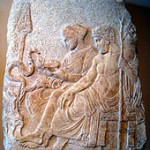 The latest series to be uploaded into the Sleep and Dream Database (SDDb) is the biggest yet: the “Brianna Journal 1984-2016,” 2,448 dream reports from a woman who kept a journal fairly consistently for 32 years. This series offers an amazing opportunity to observe in unusually close detail the emotional contours of an individual’s life as she makes her way through a challenging and often dangerous world.
The latest series to be uploaded into the Sleep and Dream Database (SDDb) is the biggest yet: the “Brianna Journal 1984-2016,” 2,448 dream reports from a woman who kept a journal fairly consistently for 32 years. This series offers an amazing opportunity to observe in unusually close detail the emotional contours of an individual’s life as she makes her way through a challenging and often dangerous world.
Brianna (not her real name) shared these dreams with me and Deirdre Barrett last year, which we initially studied for a presentation at the 2016 conference of the International Association for the Study of Dreams. Using the word search functions of the SDDb, I performed a “blind analysis” on three subsets of Brianna’s dream journals, meaning I 1) tabulated the frequencies of word usage for several categories of dream content, 2) compared her frequencies with baseline averages for each category, and 3) made inferences, based on nothing other than her dream patterns, about her concerns and activities in waking life. For instance, I inferred that Brianna is closer to her mother than her father, is interested in books and writing, is not interested in sports, and has significant involvement with issues of death and dying. Brianna herself, who attended the conference presentation, confirmed these and other inferences, which helped demonstrate the general idea that patterns in dreaming can accurately reflect people’s waking life concerns.
Now I have finally uploaded the complete collection of dreams Brianna shared with me, which provides a broader overview of her dreaming experiences over the span of more than three decades. I will share more details from my analysis at the upcoming 2017 IASD conference (held in Anaheim, California, June 16-20). For now, here are some of the initial findings of my study of this remarkable series.
Length: This is a long series in at least three ways: total number of dreams (2,448), time span covered by the journals (32 years), and average number of words per report (292). The median word length is 168 words, meaning half the reports are shorter than that, and half the reports are longer. Looking at the distribution of word lengths in the series as a whole, 851 of the dreams have between 1 and 99 words, 794 of the dreams have between 100 and 299 words, and 803 of the dreams have 300 or more words. A series with this many dreams at both the short and long ends of the spectrum poses special challenges for analysis. For now, I will study the series as a whole, but at some point I will look at subsets of varying lengths (e.g., the dreams of 50-300 words in length, of which there are 1,192).
Cognition: The series as a whole has a remarkably high frequency of dreams with at least one word relating to thinking (71%), speaking (56%), and reading/writing (19%). The dreams have lots of strange, irrational material, too, but much of the content is oriented around normal cognitive activities that are also important in her waking life (Brianna is, in fact, a literate, well-educated, and sociable person). The high proportion of cognition references could be a result of the unusual length of her dreams, and/or it could be an accurate reflection of her waking personality. Either way, this is a topic worth further investigation.
Death: One out of every seven (15%) of Brianna’s dreams has a reference to death. That is quite high compared to other dream series I have studied, and it strongly suggests that death and dying are major concerns in Brianna’s waking life. I know enough about her to confirm the general accuracy of this inference, and now I am curious to look more closely at how this theme weaves its way through her series as a whole.
Religion: The frequency of references to religion is also unusually high in this series, and the list of specific words used in the dreams makes it fairly easy to accurately infer that Brianna is Jewish. In previous studies I have found that patterns in dreaming offer good clues to a person’s beliefs and attitudes towards religion. The Brianna series seems to be another illustration of that premise, and through deeper analysis I hope to understand better how religious and spiritual themes in the dreams track with Brianna’s waking life interests, concerns, and experiences.
Note: this post was originally published in Psychology Today, March 10, 2017.

